Spring Morning, Paris
It is still early. A clean morning: a walk along the canal de St Martin to the Gare de Lyon appeals much more than taking the Metro, and meets only minimal, even token, resistance from My Lady Of The Needles. For it is one of those late winter mornings which promises delight to all the senses, touch, taste, smell, hearing, and sight, a morning when the senses play a polyphony of experience into consciousness, greater than the sum of the parts. The play of light on streets wet from last night’s heavy rain…the smell of coffee… a gull crying the call of my coastal childhood… this is a morning, a light, the Impressionists would have enjoyed.
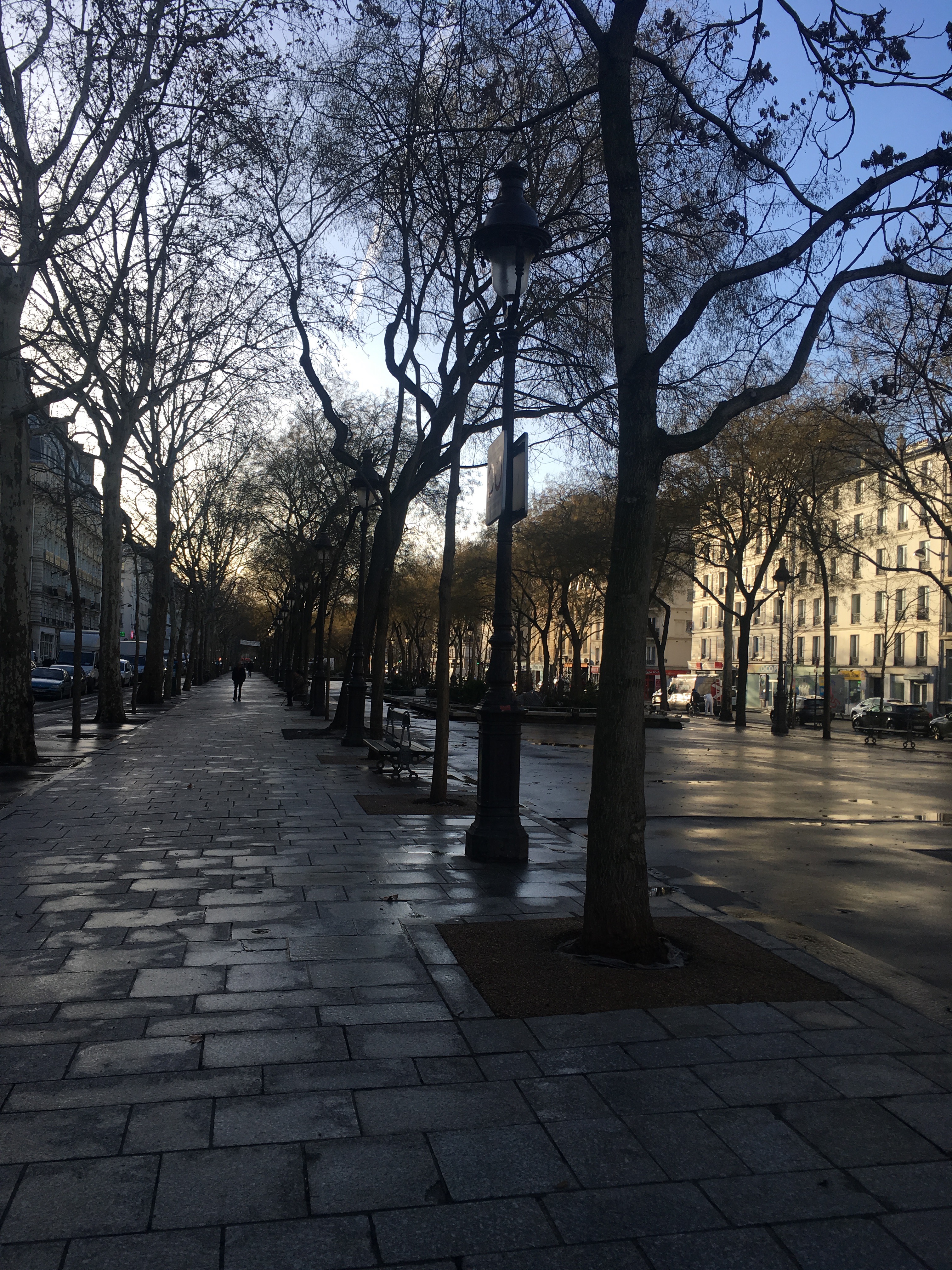
The low sun glances off the puddles on this bright side of the street. I feel warmth on my face. The cars’ passage parts the puddles, and the waters stand for a moment on the right hand and on the left before a miniature crashing together once more into momentary, even stillness. The slight convexity of pavé shines in the fresh light, etching the separateness of each block. Feet feel that unevenness: not unpleasant, and much better than miles of smooth tarmac. People hurry to work, purposeful, briefcased, shoppingbagged. A man whizzes past, elegantly poised on the footboard of one of those electric scooters. A little arc of water catches the light as his wheels slice through a puddle, a flourish behind his back wheel. His scooter is deceptively like the ones we had as kids – save for the silent motor. I want one. It would be ideal for getting from College to the UL. But I know My Lady Of The Needles will forbid it, as she (and the rest of them) have forbidden me roller blades which I know I could manage well. She catches me looking longingly and simply shakes her head, the corners of her mouth firm set. Oh well.
An elegant middle aged woman is taking her dog for its constitutional. French bulldogs are a breed I regret. He is on a pink lead, which, to my mind, serves it right. She tries to hide her clear if well-bred impatience, while it squats uglily and extrudes slowly. It rolls its eyes at me, showing the whites as I pass, as if to sneer, ‘Pooh ! Seen your sort before.’ That breed does. They sense I do not like them.
Cheerful, chatting, emphatic builders have to get their stuff through one of those graceful windows with pale green shutters of a fifth floor apartment in a Second Empire block. Just above is the (oh so French !) hipped roof of blue slate. Their hydraulic lift is fixed on the back of a common or garden lorry, and it reaches up over the trees that line the street along the canal. (I would love to play with that hoist.) No longer is the canal a busy carrier of trade, though you can see what it was once from the size of the lock. Water dribbles over its mossed green gates.

Pretty footbridges in green painted cast iron at regular intervals cross the water, hipped up like bridges on willow pattern plates to let the long gone barges through. (Why did we both think of Monet’s bridge at Giverney? They are nothing like it.) Roads span it on swing bridges. Just for the fun of it, we cross each that we come to. Cast iron lamposts from the Belle Epoque, elegant, graceful, with incongruous tendrils of iron ivy spiralling up them, remind of a time when mere function was not the only criterion in designing things.
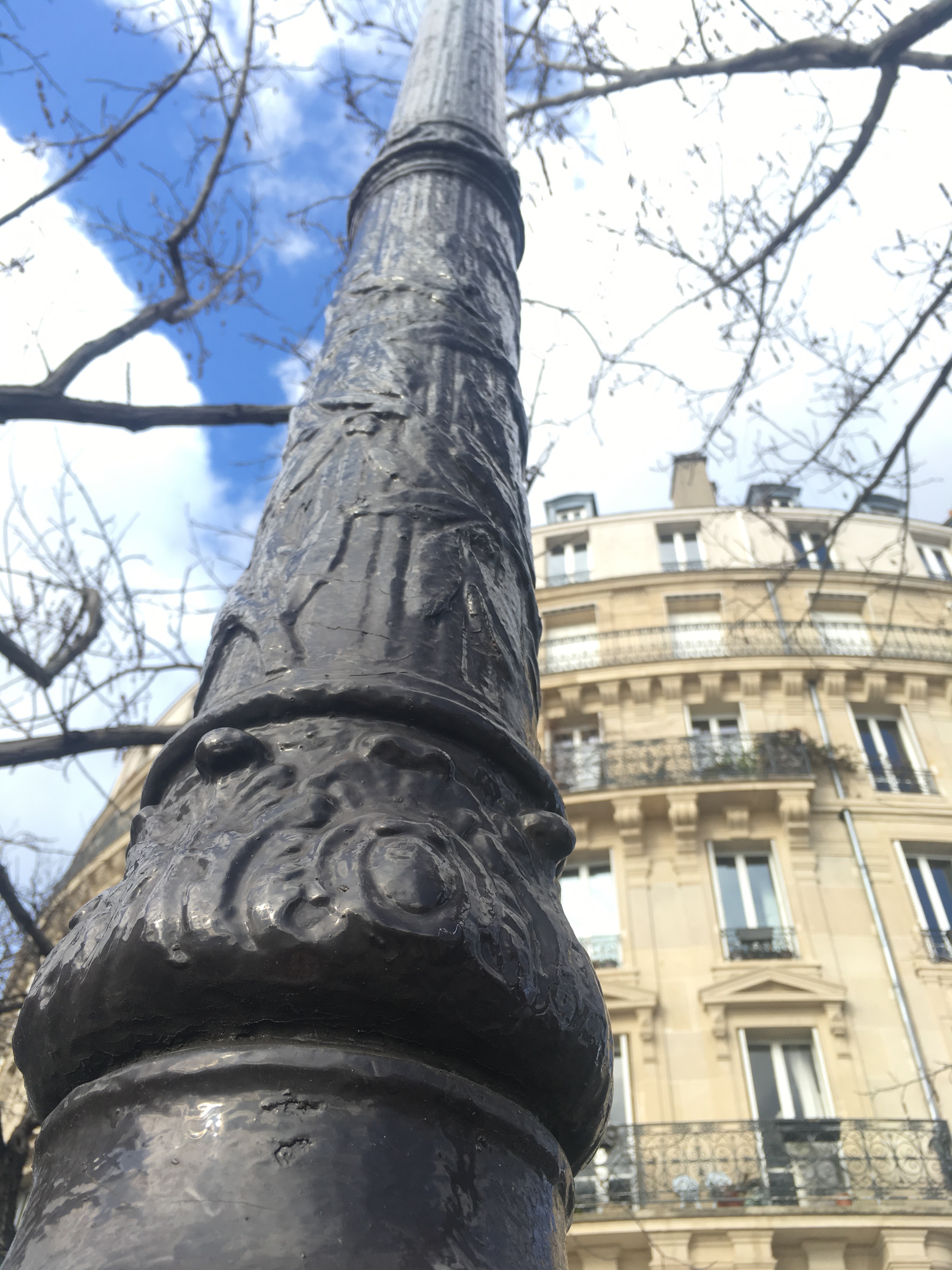
For an instant I am back in Bucharest, opulently built with much French iron and taste before the World went mad in 1914. Possibly the lamp posts there came from that same foundry…The iron has the same patina and cold, slightly uneasily greasy, feel as the cast iron curvaceous dolphins on the balustrades on the North Pier at Blackpool where I used to fish as a boy. We pass a wall covered in Art Nouveau majolica tiles, the design swirling across the hard straight edges of each tile. A pretty permanent advert…
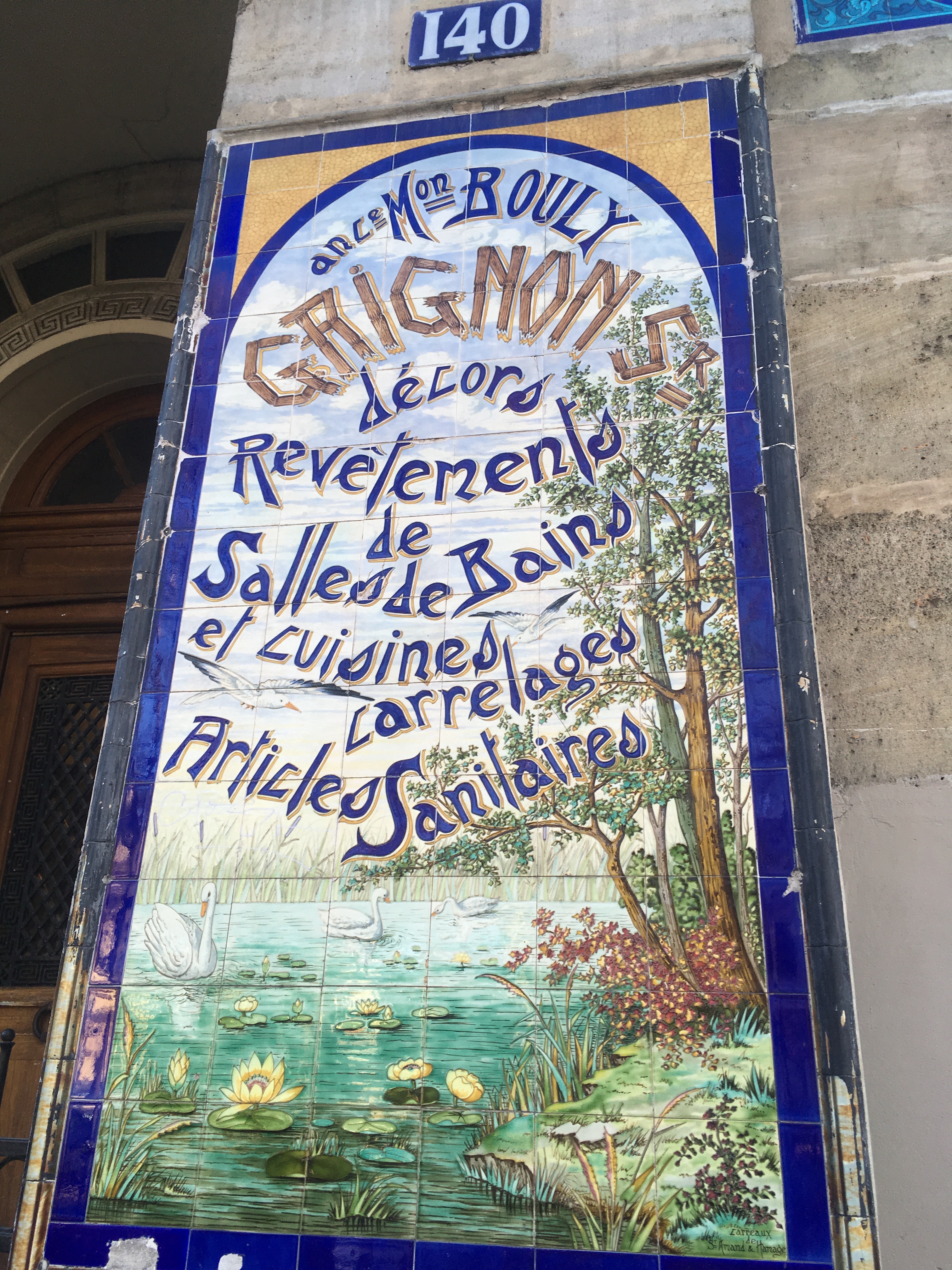
Further down towards the Seine they have filled in the canal and made it a park. Once it joined the river and its busy trade at the Arsenal, but the Arsenal is now a haven for flashy pleasure boats and expensive houseboats. (One or two fly the Red Ensign, I see, and on the mast for the satellite dish a courtesy tricolour. No prize for guessing their politics.)
The market is busy: people still seem to buy food for the day fresh… which makes me think about the little miracle of towns. I am a pretty pessimistic sort of chap, often with good reason, but it does no harm from time to time to remind oneself that 99.9% of the enormously complicated things that human beings make, from railways to sewers to sewing machines to computers, actually work, and make and rely on a net of interdependence. And, also, that 99% of the time most people behave decently to each other. One of the most complicated things of all is a town and the trust between people and in things that makes it possible. That little old lady in this morning market, her mouth perpetually in a moue after a lifetime of speaking French, her basket on her arm, looking disdainfully at the cauliflower she will soon buy – the fact that she is there depends on so many unrelated things all going right. The chain from her shaking her head even as she samples the cheese leads back through so many links to someone near Parma bringing a cow in for the milking. It is well to remind oneself that through all the horrors that fill our newspapers and our history books someone, somewhere, was patiently growing the food, getting in the harvest, singing the children to bed, cooking a meal for sharing with family or friend.
I dawdle in markets as I did when a kid, even when being told to hurry up. I love food stalls especially. Several fish stalls offer various delights, vying with each other in the beauty of fish – they are some of the most beautiful creatures on the planet, to my mind – laid out in bright patterns on beds of ice. A dozen St Pierre (which I know as John Dory) are laid out overlapped like scales, with their open mouths all emptily threatening the nearby sprats. Octopus, mackerel, soles, plaice, turbot, a pile of mussels. Oysters, gnarled grey ancients, from the Belon or Cancale. All the colours and smell I love of a fish market. Stall after stall. And then, the meat stalls, real meat, not plastic-packed supermarket stuff that could have come off a loom. You can see these were real whole rabbits that once ran around, that the cuisses de canard, and magret de canard, came off real ducks; geese; poulets, poussin (poor man being called that! How did he ever get people to take his painting seriously when he was just starting out!) And brother in law Marcel told me later, when we were flash frying strips of magret on his plancha, that magret comes from a duck that has been fed up for foie gras. I did not know that. Then the technicolour of vegetables; oranges piled into pyramids, fat green fists of broccoli… I see why the Dutch used to paint this plenitude. Riches. Bunches of fresh mimosa in buckets remember the sunlight of the Midi whence they have come, promising spring.
Then smells: it used to be drains, of course, in France when I was young. The market odorous with the seductiveness of flowers, the salty call of fish, so powerful a reminder of Fleetwood when the trawler I had been working on was unloading for the auction of her catch. The vibrancy of a fine cheese stall summarises odours from all over France and beyond. The patron has a huge Gorgonzola, a Gorgonzola of noble proportions, ancient lineage and hearty deliquescence, from which he is spooning out generous portions for his customers, with strings of succulence hanging from the spoon as he lifts it. People talk, chatter, good tempered. A place for news, gossip with neighbours, chaff with familiar stall holders. None of the tedious, dash-to-the-checkout, anonymity of the supermarket. A stall sells cheap and colourful clothes. Another offers gloves and bags and belts and, quite free, the wonderful smell of new leather. This is what towns used to be like – like I remember in Kendal, or Poulton, or Bury.
We rejoin the world of now below the newly gilded statue of The Spirit of Liberty in the place de la Bastille. O liberty, what crimes are committed in thy name, as Mme Roland said as she was taken to the guillotine in the square they named after Concord – not, of course, the plane. Cars roar round where once stood the ancient fortress. When the revolutionaries stormed it in 1789 they found there were hardly any prisoners in it, for Louis’ government was pretty enlightened. But then: every revolution has to have its myths, facts rarely matter, and as de Tocqueville remarked, revolutions happen when things are getting better. We pass the sleek, gross bulk of the Opera Bastille, which gives no suggestion of a harmony within, to drop our cases at the left luggage at the station, down in the underworld below Platform N. Unburdened, no longer dogged by the tacktacktacketytacketytack of wheels never in synch with each other, on we go past the Jardin des Plantes. I tell My unimpressed Lady Of The Needles, about the ancient and still thriving Robinia planted as a seed brought from England in 1601 by Jean Robin, royal gardener to Henri IV and Louis XIII. (The tree was named after him. He called his son Vespasian.)
Along the Boulevard St Germain, another of those long broad streets laid out, ignoring the ancient street pattern of old Paris, by Baron Haussman to allow a straight line of fire for the cannon should the Parisians get restive again – as they had done in 1789 and 1830 and in 1848. On the right, glimpses of the Isle St Louis, then the chevet of Notre Dame; to the left, names resonating with associations: rue des Bernardines where the Cistercian convent is/was, and nearby the rue du Mont St Genevieve, where perhaps she was martyred, but certainly where Peter Abelard taught Heloise. Then the rue St Jacques, where the Jacobins hung out hatching all sorts of things, and then up the steep river terrace which a bigger, younger Seine made long before men called this place Lutetia, to the Rue des Ecoles. Knee deep in history, we pass the College de France which Francis I founded so that Paris could have its answer to the Florentine Academy. It must have been near here that the theologians of the University of Paris debated the King’s Great Matter, Henry’s proposed divorce from the Pope’s niece. I find it so hard not to be overwhelmed by the past in places like this. But awakening comes: a noisy siren procession of police vehicles elbows its way though the traffic… six, seven, eight… an ambulance… are we going to see the start of another revolution? I had a pupil once who was playing hooky in Berlin and found he was in exactly the spot where and when the Wall was breached. He made a journalistic reputation with that story and has never looked back – or had such luck again.
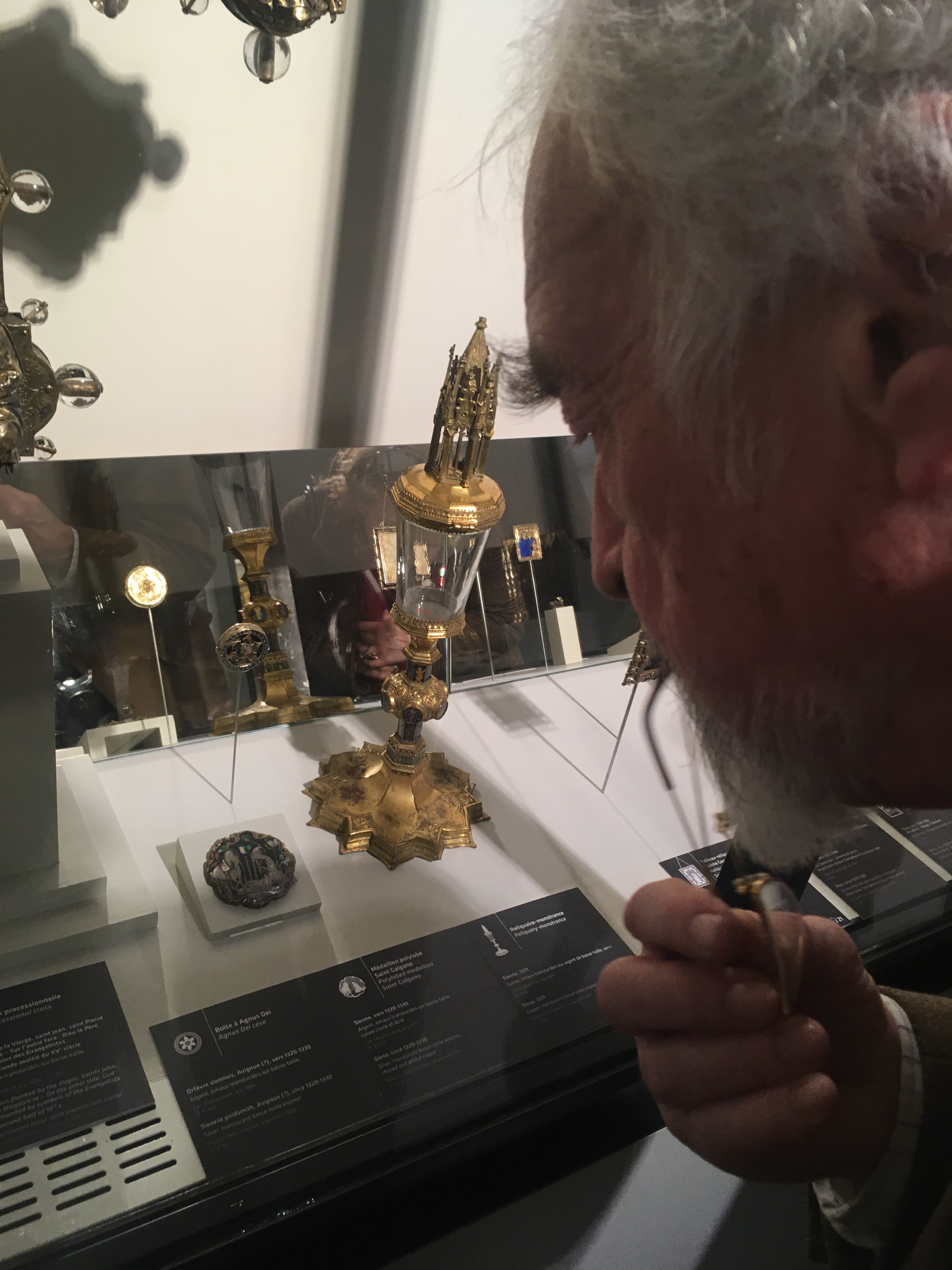
To the Hotel de Cluny, for a refreshing dose of the middle ages. A gold reminder of Alaric the Visigoth, King of Tolosa, dazzles My Lady. An ivory casket with scenes from the fashionable romances – the Mills and Boons of the middle ages; an oliphant; an ivory Madonna and Child; a gold retable of Pentecost from Bamberg; and the Tapestries of the Senses of la Dame a la Licorne. A magnificent copy of Augustine’s City of God in French is next to a huge antiphoner, and My Lady in her soft alto hummed the open page of the Office, for she can sing that music at sight.
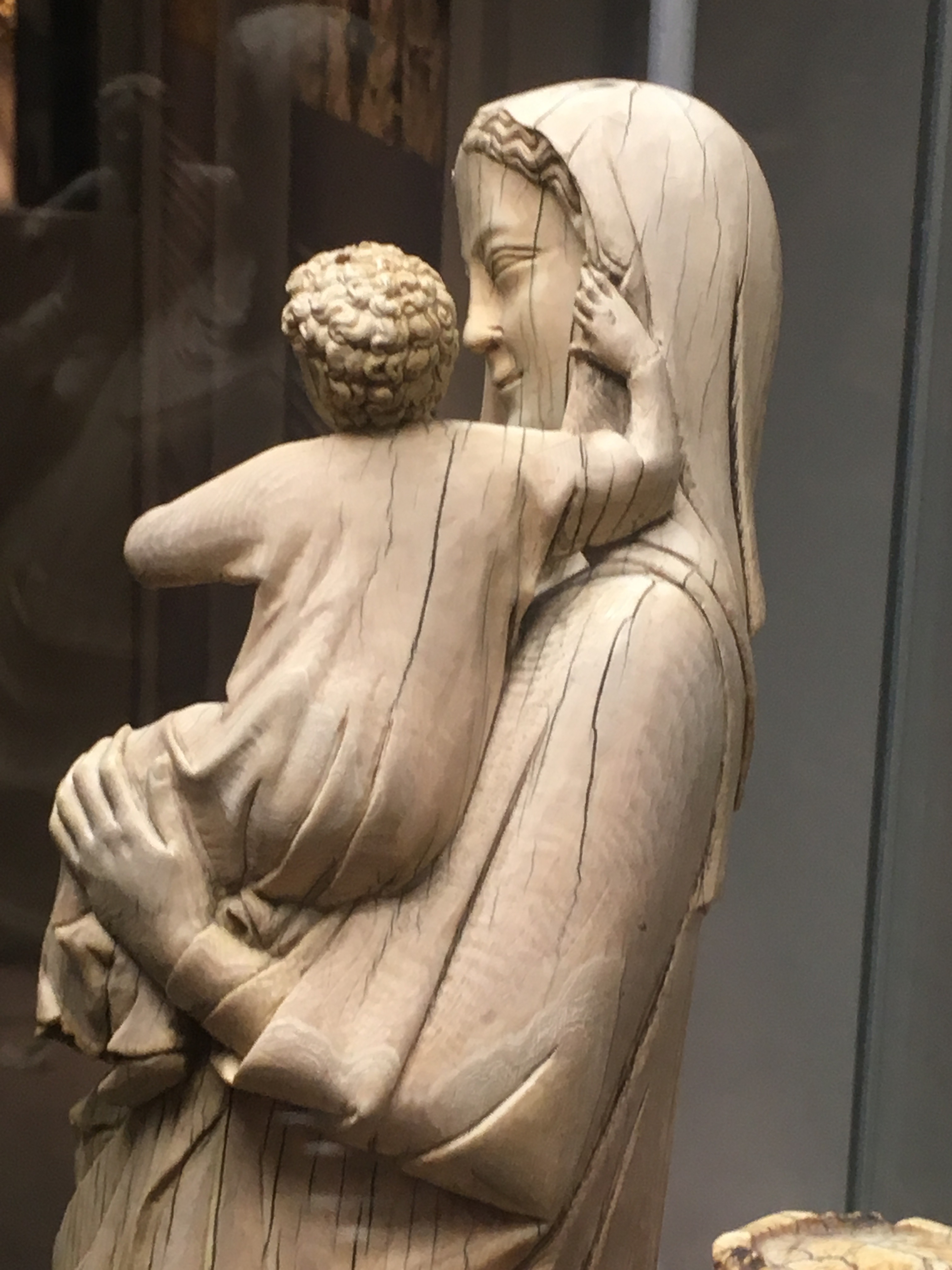
To lunch. Next to us three workmen tucking in to soup and entrecote and creme brulee and wine. Next to them an elderly lady, whom clearly the waiter knows, is helped to a seat. She probably eats here every day. I can see why. Look no further. A framed poster promises LE BONHEUR ETERNEL – at the World Cup Final. (Something wrong somewhere. But we shall not argue.)
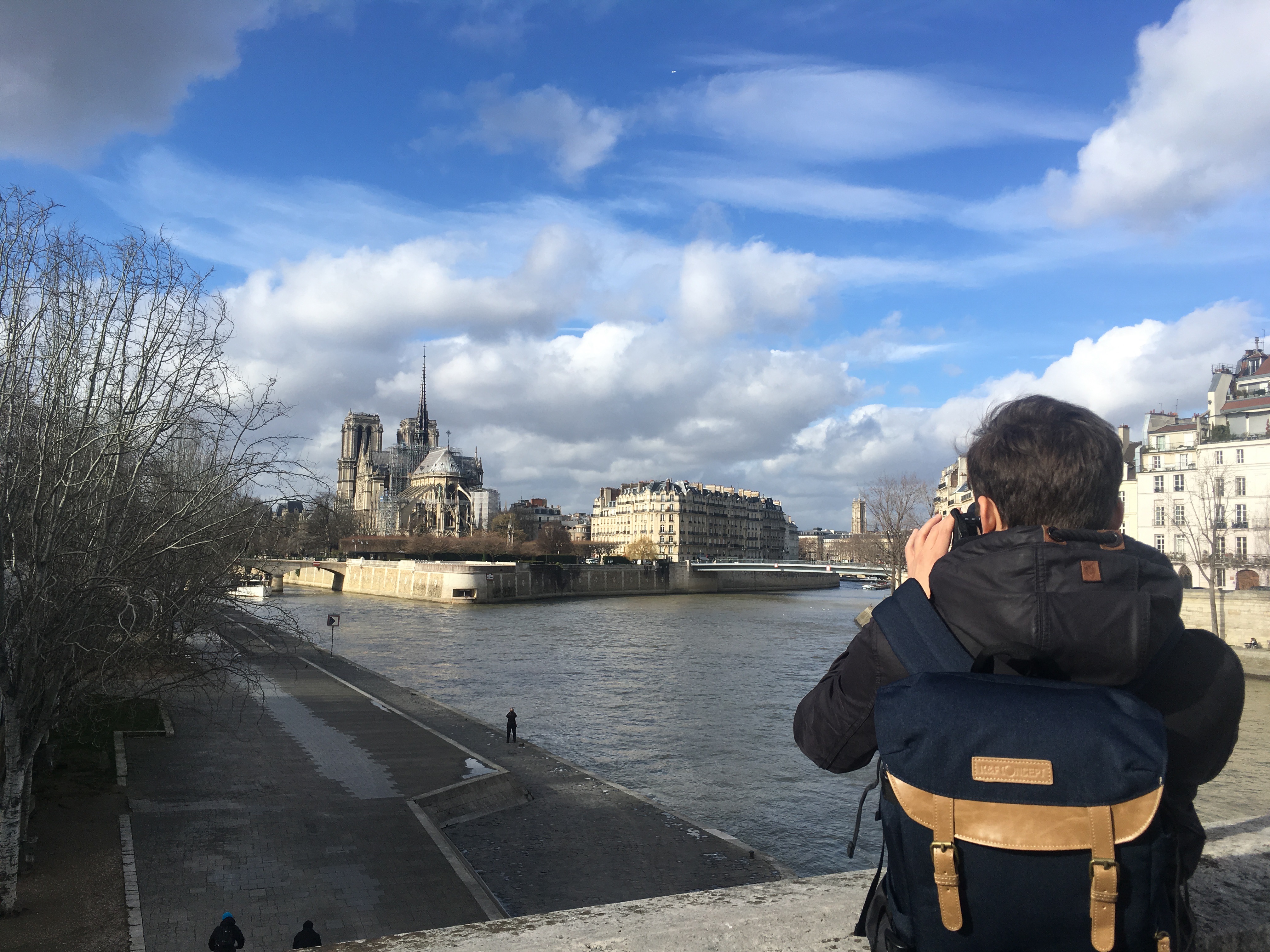
Now benignly replete, we begin our gentle amble back to catch our train via the quiet streets, the Pont de la Tournelle, the Ile St Louis. The bridge offers a grand view of people taking photos of Notre Dame and sitting by the river, spaced as evenly as nesting gulls, engrossed in phones.
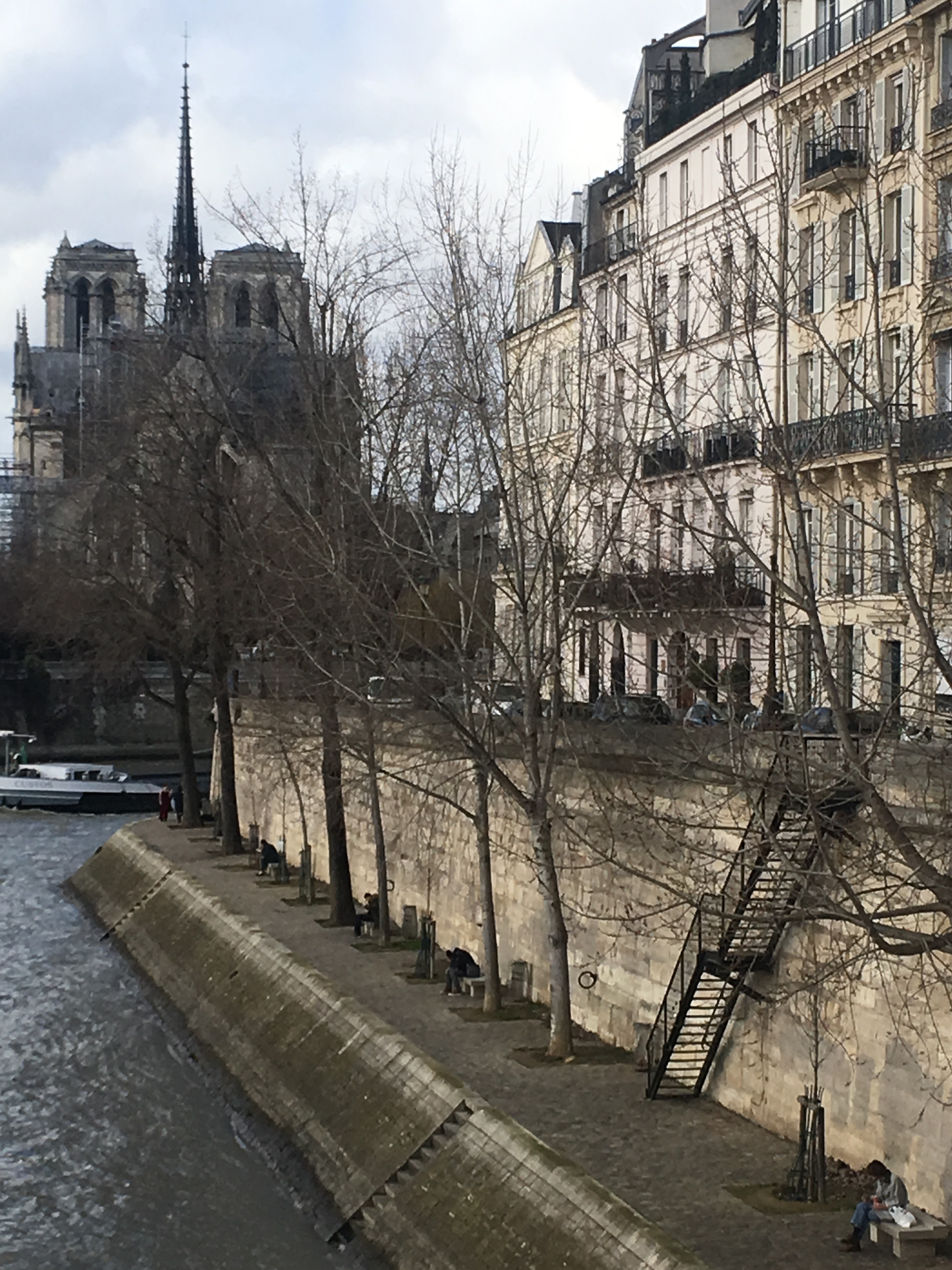
Berthillon’s salon de thé – you can’t call anything as self consciously grand as that a tea shop – unsuccessfully tempts with promises of chocolate and ice cream Almost opposite is a barber’s that perhaps Bertie Wooster would have liked.
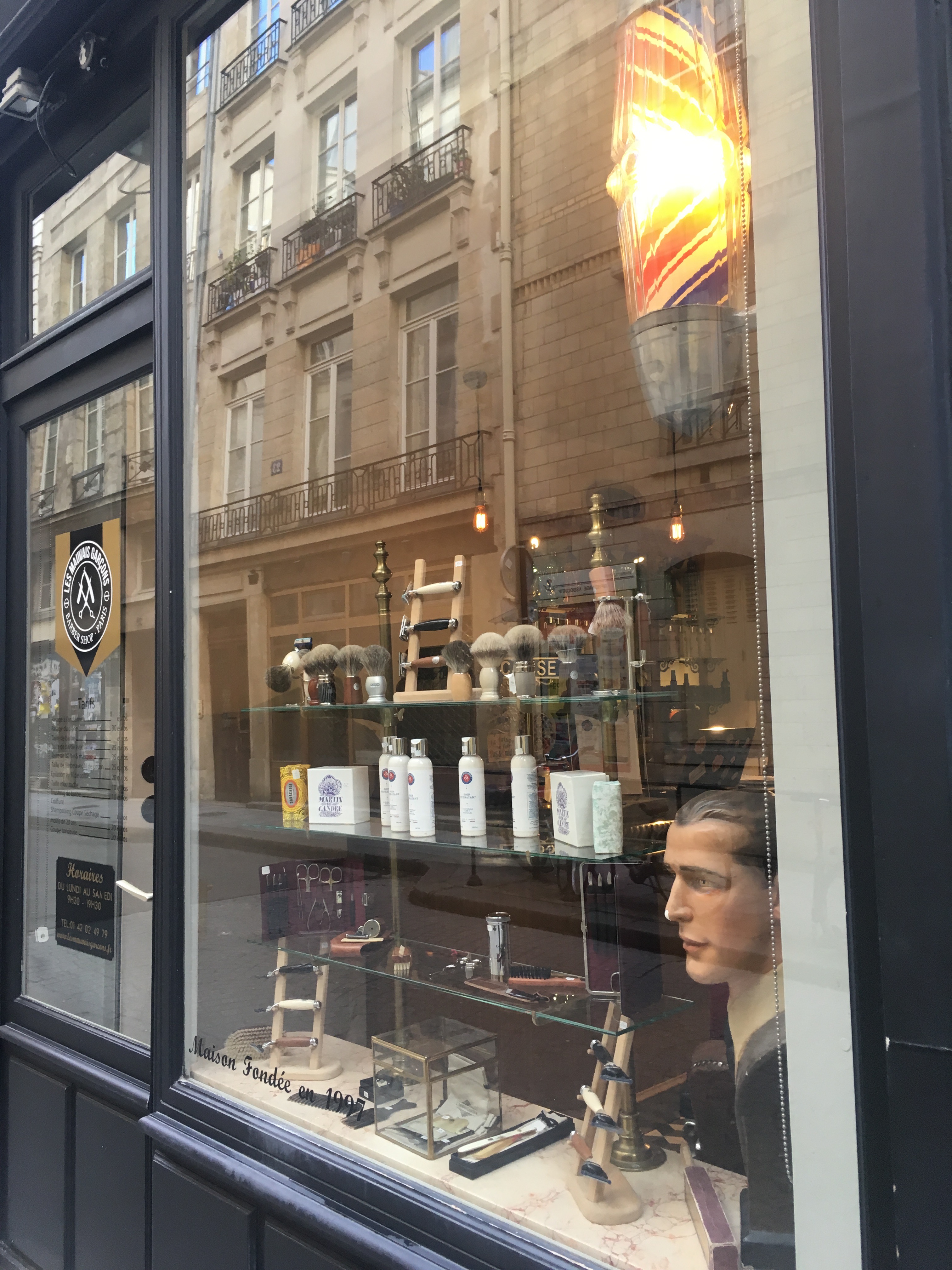
And through the windows of an elegant first floor flat, we glimpse the unlit candles in a chandelier. Some are askew. But style, even so.
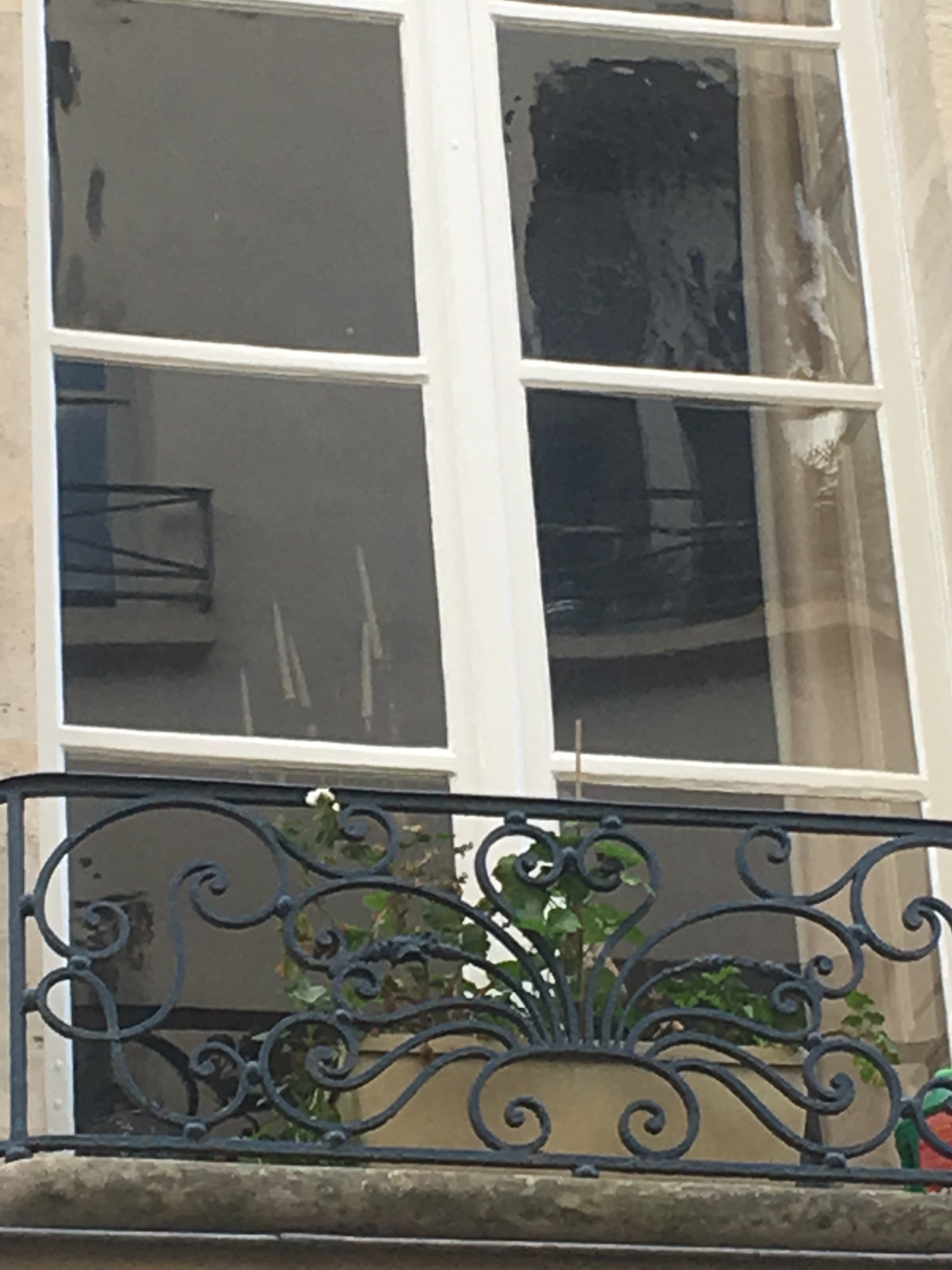
What is the sixth sense, a mon seul desir ? Is it memory, or that longing, sehnsucht, for that which promises, beckons, beyond the immediate physical senses, where all are transfigured into one, without now, or then, or will be?
And just for fun, try typing on a French keyboard. And I am a terrible typist even on an English one.
We bought some madeleines for the journey.

